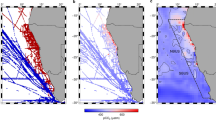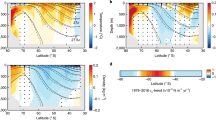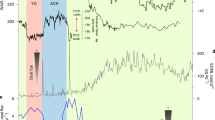Abstract
Modelling studies have demonstrated that the nutrient and carbon cycles in the Southern Ocean play a central role in setting the air–sea balance of CO2 and global biological production1,2,3,4,5,6,7,8. Box model studies1,2,3,4 first pointed out that an increase in nutrient utilization in the high latitudes results in a strong decrease in the atmospheric carbon dioxide partial pressure (). This early research led to two important ideas: high latitude regions are more important in determining atmospheric than low latitudes, despite their much smaller area, and nutrient utilization and atmospheric are tightly linked. Subsequent general circulation model simulations show that the Southern Ocean is the most important high latitude region in controlling pre-industrial atmospheric CO2 because it serves as a lid to a larger volume of the deep ocean5,6. Other studies point out the crucial role of the Southern Ocean in the uptake and storage of anthropogenic carbon dioxide7 and in controlling global biological production8. Here we probe the system to determine whether certain regions of the Southern Ocean are more critical than others for air–sea CO2 balance and the biological export production, by increasing surface nutrient drawdown in an ocean general circulation model. We demonstrate that atmospheric CO2 and global biological export production are controlled by different regions of the Southern Ocean. The air–sea balance of carbon dioxide is controlled mainly by the biological pump and circulation in the Antarctic deep-water formation region, whereas global export production is controlled mainly by the biological pump and circulation in the Subantarctic intermediate and mode water formation region. The existence of this biogeochemical divide separating the Antarctic from the Subantarctic suggests that it may be possible for climate change or human intervention to modify one of these without greatly altering the other.
This is a preview of subscription content, access via your institution
Access options
Subscribe to this journal
Receive 51 print issues and online access
$199.00 per year
only $3.90 per issue
Buy this article
- Purchase on Springer Link
- Instant access to full article PDF
Prices may be subject to local taxes which are calculated during checkout



Similar content being viewed by others
References
Sarmiento, J. L. & Toggweiler, J. R. A new model for the role of the oceans in determining atmospheric pCO2 . Nature 308, 620–624 (1984)
Knox, F. & McElroy, M. B. Changes in atmospheric CO2: Influence of the marine biota at high latitude. J. Geophys. Res. 89, 4629–4637 (1984)
Siegenthaler, U. & Wenk, T. H. Rapid atmospheric CO2 variations and ocean circulation. Nature 308, 624–626 (1984)
Joos, F., Sarmiento, J. L. & Siegenthaler, U. Estimates of the effect of Southern Ocean iron fertilization on atmospheric CO2 concentrations. Nature 349, 772–775 (1991)
Sarmiento, J. L. & Orr, J. C. Three-dimensional ocean model simulations of the impact of Southern Ocean nutrient depletion on atmospheric CO2 and ocean chemistry. Limnol. Oceanogr. 36, 1928–1950 (1991)
Marinov, I. Controls on the Air-Sea Balance of Carbon Dioxide. PhD thesis, Princeton Univ. (2005)
Caldeira, K. & Duffy, P. B. The role of the Southern Ocean in uptake and storage of anthropogenic carbon dioxide. Science 287, 620–622 (2000)
Sarmiento, J. L., Gruber, N., Brzezinski, M. A. & Dunne, J. P. High-latitude controls of thermocline nutrients and low latitude biological productivity. Nature 427, 56–60 (2004)
Sigman, D. M. & Boyle, E. A. Glacial/interglacial variations in atmospheric carbon dioxide. Nature 407, 859–869 (2000)
Toggweiler, J. R., Russell, J. L. & Carson, S. R. Mid-latitude westerlies, atmospheric CO2 and climate change during the Ice Ages. Paleoceanography 21, PA2005, doi:10.1029/2005PA001154 (2006)
Kohfeld, K. E., Le Quere, C., Harrison, S. P. & Anderson, R. F. Role of marine biology in glacial-interglacial CO2 cycles. Science 308, 74–78 (2005)
Gordon, A. in Antarctic Oceanology I (ed. Reid, J. L.) Antarctic Res. Ser. Vol. 15, 169–203 (American Geophysical Union, Washington DC, 1971)
Toggweiler, J. R. & Samuels, B. Effect of Drake Passage on the global thermohaline circulation. Deep-sea Res. I 42, 477–500 (1995)
Wyrtki, K. The thermohaline circulation in relation to the general circulation in the oceans. Deep-Sea Res. 8, 39–64 (1961)
Sverdrup, H. U., Johnson, M. W. & Fleming, R. H. The Oceans, Their Physics, Chemistry, and General Biology (Prentice-Hall, New York, 1942)
Schmitz, W. J. On the interbasin-scale thermohaline circulation. Rev. Geophys. 33, 151–173 (1995)
Ito, T. & Follows, M. J. Preformed phosphate, soft tissue pump and atmospheric CO2 . J. Mar. Res. 63, 813–839, doi:10.1357/0022240054663231 (2005)
Dutkiewicz, S., Follows, M. J. & Parekh, P. Interactions of the iron and phosphorus cycles: a three dimensional model study. Glob. Biogeochem. Cycles 19, GB1021, doi:10.1029/2004GB002342 (2005)
Toggweiler, J. R., Dixon, K. & Broecker, W. S. The Peru upwelling and the ventilation of the South Pacific thermocline. J. Geophys. Res. 96, 20467–20497 (1991)
Toggweiler, J. R., Murnane, R., Carson, S., Gnanadesikan, A. & Sarmiento, J. L. Representation of the carbon cycle in box models and GCMs–Part 2. Organic pump. Glob. Biogeochem. Cycles 17, 1027, doi:10.1029/2001GB001841 (2003)
Toggweiler, J. R. Variation of atmospheric CO2 by ventilation of the ocean's deepest water. Paleoceanography 14, 571–588 (1999)
Martin, J. H. Glacial-interglacial CO2 change: the iron hypothesis. Paleoceanography 5, 1–13 (1990)
Stephens, B. B. & Keeling, R. F. The influence of Antarctic sea ice on glacial–interglacial CO2 variations. Nature 404, 171–174 (2000)
Najjar, R. & Orr, J. Design of OCMIP-2 simulations of chlorofluorocarbons, the solubility pump and common biogeochemistry. <http://www.cgd.ucar.edu/ oce/OCMIP/design.pdf> (1998).
Gnanadesikan, A., Slater, R. D., Gruber, N. & Sarmiento, J. L. Oceanic vertical exchange and new production: a comparison between models and observations. Deep Sea Res. II 49, 363–401 (2002)
Gnanadesikan, A., Slater, R. D. & Samuels, B. L. Sensitivity of water mass transformation and heat transport to subgridscale mixing in coarse-resolution ocean models. Geophys. Res. Lett. 30, 1967, doi:10.1029/2003GL018036 (2003)
Speer, K., Rintoul, S. R. & Sloyan, B. The diabatic Deacon cell. J. Phys. Oceanogr. 30, 3212–3222 (2000)
Sloyan, B. M. & Rintoul, S. R. The Southern Ocean limb of the global deep overturning circulation. J. Phys. Oceanogr. 31, 143–173 (2001)
Acknowledgements
I.M. was supported by the DOE Office of Science while at Princeton University, and by the NOAA Postdoctoral Program in Climate and Global Change, administered by the University Corporation for Atmospheric Research, while at MIT. We thank R. Slater for help with the Princeton GCM, D. Sigman and M. Follows for discussions, and R. Anderson for comments that improved the manuscript.
Author information
Authors and Affiliations
Corresponding author
Ethics declarations
Competing interests
Reprints and permissions information is available at npg.nature.com/reprintsandpermissions. The authors declare no competing financial interests.
Supplementary information
Supplementary Notes
This file contains contains Supplementary Discussion, Supplementary Table 1 and Supplementary Figures 1–3. (PDF 228 kb)
Rights and permissions
About this article
Cite this article
Marinov, I., Gnanadesikan, A., Toggweiler, J. et al. The Southern Ocean biogeochemical divide. Nature 441, 964–967 (2006). https://doi.org/10.1038/nature04883
Received:
Accepted:
Issue Date:
DOI: https://doi.org/10.1038/nature04883
This article is cited by
-
Abyssal ocean overturning slowdown and warming driven by Antarctic meltwater
Nature (2023)
-
Recovery from microplastic-induced marine deoxygenation may take centuries
Nature Geoscience (2023)
-
Slowing of the ocean’s deep breath
Nature Climate Change (2023)
-
Wind-driven upwelling of iron sustains dense blooms and food webs in the eastern Weddell Gyre
Nature Communications (2023)
-
Abruptly attenuated carbon sequestration with Weddell Sea dense waters by 2100
Nature Communications (2022)
Comments
By submitting a comment you agree to abide by our Terms and Community Guidelines. If you find something abusive or that does not comply with our terms or guidelines please flag it as inappropriate.



